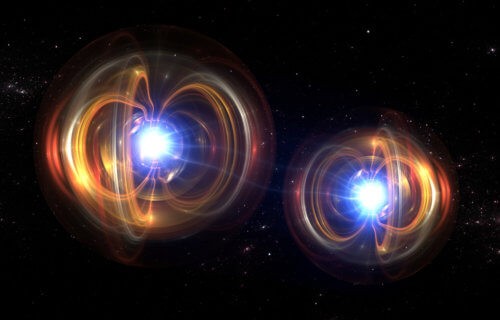-
Futuristic tech successfully locates hidden tunnel underground, paving way for map of world underneath Earth’s surface
-
Physicists say new quantum tech may be able to predict earthquakes, volcanic eruptions
BIRMINGHAM, England — British scientists are celebrating an extraordinary breakthrough that could revolutionize everything from archaeology to geology to national security. For the first time ever, a quantum gravity sensor successfully identified objects hidden deep underground.
The milestone paves the way for drawing a map of the mysterious world under the Earth’s surface. Researchers at the University of Birmingham say the device, call a quantum gravity gradiometer, can locate artifacts, structures and other objects buried below ground. It could even predict earthquakes and volcanic eruptions.
In a groundbreaking experiment, the quantum gravity gradiometer detected a tunnel buried outdoors about three-feet down between two multi-story buildings in Birmingham. It has implications for industry, human knowledge and national security, physicists say.
“This is an ‘Edison moment’ in sensing that will transform society, human understanding and economies,” says principal investigator Kai Bongs, Head of Cold Atom Physics at the university, in a statement. “With this breakthrough we have the potential to end reliance on poor records and luck as we explore, build and repair. In addition, an underground map of what is currently invisible is now a significant step closer, ending a situation where we know more about Antarctica than what lies a few feet below our streets.”
The quantum gravity gradiometer was created for the United Kingdom’s Ministry of Defence. It’s the first time the technology has worked outside a laboratory — a major victory in an international race.
The tool works by detecting variations in microgravity at the atomic level. It opens the door to dramatic improvements in charting what exists below the ground. Benefits include reduced costs and delays to construction, rail and road projects. It may help predict naturally occurring events like volcanic eruptions or movement along fault lines.
It also offers hope of discovering hidden natural resources, built structures and archaeological mysteries without damaging excavation.
“It has potential for a range of applications,” says lead author Dr. Michael Holynski, Head of Atom Interferometry at Birmingham. “Civil engineers might be able use it to inspect brownfield sites for near surface features that could affect new constructions. Archaeologists may find it useful for mapping out tombs and structures hidden beneath the ground. It could even find use in the measurement of geological features such as aquifers or soil density to determine water content.”
Current gravity sensors face a range of environmental problems such as vibration which cuts measurement time for survey applications. The tool will make them ten times faster, more comprehensive and cheaper, taking a few days rather than a month.
“Detection of ground conditions such as mine workings, tunnels and unstable ground is fundamental to our ability to design, construct and maintain housing, industry and infrastructure,” adds co-author George Tuckwell, Director for Geoscience and Engineering at RSK, an environmental and engineering company. “The improved capability that this new technology represents could transform how we map the ground and deliver these projects.”
Quantum systems are highly sensitive to their surroundings. The team’s design was demonstrated by performing a survey. The instrument found the tunnel – measuring two by two meters – under a road surface in the busy city center.
“For national defense and security, accurate and rapid measurements of variations in microgravity open up new opportunities to detect the otherwise undetectable and navigate more safely in challenging environments,” says co-author Dr. Gareth Brown, joint Project Technical Authority for Quantum Sensing and Senior Principal Scientist for the UK’s Defence Science and Technology Laboratory. “As gravity sensing technology matures, applications for underwater navigation and revealing the subterranean will become possible.”
The groundbreaking findings are published in the journal Nature.
South West News Service writer Mark Waghorn contributed to this report.
